Did you receive a revenue boost through referrals? The referrals team is looking for publishers to participate in a case study, and we want to hear from you. Have you increased your AdSense earnings this way? It doesn't matter which products you're promoting on your site, or how long you've been a publisher. Feel free to send us an email and tell us about your success.
Thursday, 9 November 2006
Tuesday, 7 November 2006
A word on ad quality
We know that you’ve worked hard to create quality content for your sites, and that you look for the same quality in the ads you’re displaying. That’s why we’re happy to let you know about a change in AdWords that will improve the quality of ads.
Recently, we have begun incorporating the quality of an ad's landing page into the determination of what ads appear on your site. The quality of the ad's landing page now affects the Quality Score that the ad receives -- this score helps to determine the amount an advertiser must bid to appear on your site. The lower the Quality Score, the more "expensive" it is for the advertiser to show up on your site. As a result, you should see fewer ads on your pages which lead to low-quality sites.
And what defines low quality? We've published a general set of landing page and site guidelines. We encourage advertisers to offer relevant, substantial content so that visitors can find what they are looking for when they click on ads. Ensuring that the ads that appear on your site are high quality is an important part of our efforts to make sure that we provide the best experience for your visitors.
Posted by Andrew Chang - AdWords Product Marketing
Recently, we have begun incorporating the quality of an ad's landing page into the determination of what ads appear on your site. The quality of the ad's landing page now affects the Quality Score that the ad receives -- this score helps to determine the amount an advertiser must bid to appear on your site. The lower the Quality Score, the more "expensive" it is for the advertiser to show up on your site. As a result, you should see fewer ads on your pages which lead to low-quality sites.
And what defines low quality? We've published a general set of landing page and site guidelines. We encourage advertisers to offer relevant, substantial content so that visitors can find what they are looking for when they click on ads. Ensuring that the ads that appear on your site are high quality is an important part of our efforts to make sure that we provide the best experience for your visitors.
Posted by Andrew Chang - AdWords Product Marketing
Thursday, 2 November 2006
First impressions count
As you might already know, a great way to increase your AdSense earnings is to place multiple ad units on webpages that are rich with content. Here's a way to maximize your revenue with multiple ad units: Make sure the ad unit with the highest CTR is the first ad unit in the HTML code of your page. We've heard that there may be some confusion on this, so here's some clarification on how we serve ads to a page once we know which ads win the auction.
Currently, the first ad unit on a page always shows the top ads that win the ad auction. Also, if there aren't enough ads in our ad inventory to fill all of the ad units on a page, the first ad unit on the page will display ads first. This is why I recommend using custom channels to determine which of your ad units has the highest CTR, and then placing that ad unit first in the HTML code.
For the purposes of this post, the first ad unit on the page is defined as the first instance of the ad code within the HTML of the page. Keep in mind that the first ad unit in the source code is not always the first ad unit that your users will see when the page finishes loading in their browser. For example, if you use DIV tags, our system may recognize an ad unit which users see at the bottom of the page as the first ad unit.
Now that you know how to make the most out of multiple ad units, try this tip and watch your earnings grow.
Posted by Phoebe Ho - AdSense Optimization Team
Currently, the first ad unit on a page always shows the top ads that win the ad auction. Also, if there aren't enough ads in our ad inventory to fill all of the ad units on a page, the first ad unit on the page will display ads first. This is why I recommend using custom channels to determine which of your ad units has the highest CTR, and then placing that ad unit first in the HTML code.
For the purposes of this post, the first ad unit on the page is defined as the first instance of the ad code within the HTML of the page. Keep in mind that the first ad unit in the source code is not always the first ad unit that your users will see when the page finishes loading in their browser. For example, if you use DIV tags, our system may recognize an ad unit which users see at the bottom of the page as the first ad unit.
Now that you know how to make the most out of multiple ad units, try this tip and watch your earnings grow.
Posted by Phoebe Ho - AdSense Optimization Team
Monday, 30 October 2006
Video post: AdSense at San Jose SES
Back in August, the AdSense team landed at the Google booth at the Search Engine Strategies Conference in San Jose, CA. We had a blast meeting all of you in person, providing optimization advice on the spot, and listening to what you had to say about AdSense. Whether or not you were able to attend, I'm excited to share with you a video recap of the conference.
Didn't get a chance to meet our optimization specialists at SES? Don't worry -- you can read through their helpful 'Optimization Month' posts, or visit our Optimization Tips page to learn more about how you can optimize AdSense for your site.
Posted by Dan Friedman - AdSense Product Marketing
Didn't get a chance to meet our optimization specialists at SES? Don't worry -- you can read through their helpful 'Optimization Month' posts, or visit our Optimization Tips page to learn more about how you can optimize AdSense for your site.
Posted by Dan Friedman - AdSense Product Marketing
Thursday, 26 October 2006
EFT now available in Israel
To follow up on our announcement two weeks ago, we'd like to let you know that Electronic Funds Transfer (EFT) is now also available to publishers located in Israel. Just log in to your account and follow these instructions to set up your bank account.
You can also find a complete list of countries where EFT is offered here. Don't see your country or territory on the list? Not to worry -- we're working hard to expand our payment options, and will announce any updates right here.
Posted by Alexa Bruce - AdSense Publisher Support
You can also find a complete list of countries where EFT is offered here. Don't see your country or territory on the list? Not to worry -- we're working hard to expand our payment options, and will announce any updates right here.
Posted by Alexa Bruce - AdSense Publisher Support
Tuesday, 24 October 2006
When AdSense met Blogger (in beta)
If you have a blog on the new version of Blogger in beta, we're happy to introduce you to the drag-and-drop AdSense widget! Using this new feature, you can easily add AdSense to your blog by following these instructions.
1. First, log into the new version of Blogger with your Google Account. Click on the Layout link next to the blog where you’d like to feature Google ads.
(If you don’t see the Layout option, it’s possible that your beta blog is still in the classic template -- visit your blog’s Template page and click Customize Design. You can then upgrade your blog to the new template in minutes.)
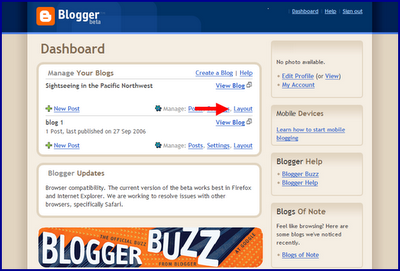
2. Next you should be taken to your Template – Page Elements page. Click on one of the Add a Page Element links shown below.
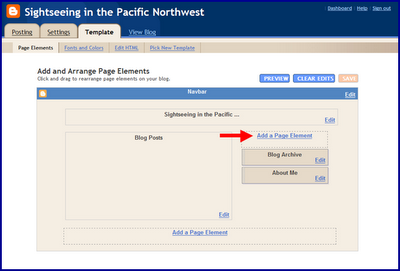
3. In the pop-up window, click the blue Add to Blog button underneath the AdSense option.
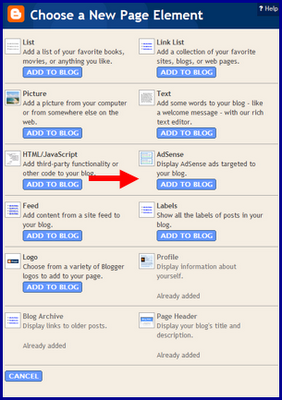
4. If you already have an AdSense account, simply sign in with your AdSense login; if not, you can create an account directly on this page. After signing in, you can select your preferred color template and ad format. When you're finished, click on the orange Save Changes button.
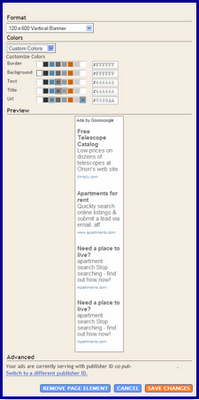
5. Now you can easily drag and drop your AdSense ad unit anywhere on your blog's template -- or delete it if you need to make changes. When you're all done, click the orange 'Save' button on the upper right corner and go view your new blog!
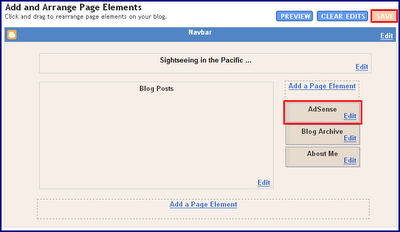
We hope you find this new feature helpful when implementing your ads. Let us know if you have any comments or suggestions.
Posted by Cathleen Jia - AdSense Publisher Support
1. First, log into the new version of Blogger with your Google Account. Click on the Layout link next to the blog where you’d like to feature Google ads.
(If you don’t see the Layout option, it’s possible that your beta blog is still in the classic template -- visit your blog’s Template page and click Customize Design. You can then upgrade your blog to the new template in minutes.)

2. Next you should be taken to your Template – Page Elements page. Click on one of the Add a Page Element links shown below.

3. In the pop-up window, click the blue Add to Blog button underneath the AdSense option.

4. If you already have an AdSense account, simply sign in with your AdSense login; if not, you can create an account directly on this page. After signing in, you can select your preferred color template and ad format. When you're finished, click on the orange Save Changes button.

5. Now you can easily drag and drop your AdSense ad unit anywhere on your blog's template -- or delete it if you need to make changes. When you're all done, click the orange 'Save' button on the upper right corner and go view your new blog!

We hope you find this new feature helpful when implementing your ads. Let us know if you have any comments or suggestions.
Posted by Cathleen Jia - AdSense Publisher Support
Monday, 23 October 2006
What's up, Docs & Spreadsheets?
Have you ever struggled to keep track of different versions of your documents or site layouts while collaborating with other webmasters? If so, you'll find Google Docs & Spreadsheets the best pain reliever ever -- it's our new web-based word processing and spreadsheet program to help manage your site's content and easily share it with others.
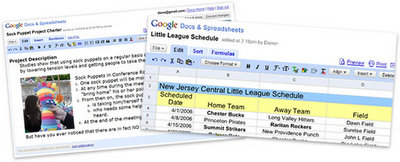
With Google Docs & Spreadsheets, you can edit and save in HTML to create mock-ups of your webpages. You're also able to access your files from any computer via a web browser, and easily send them to collaborators to review and edit. Even more exciting, you can view all past revisions to your file, so if you change your mind about that bright purple highlighting after you've put it into your document, simply revert back to a previous version.
Google Docs & Spreadsheets also provides an easy way to distribute content. Your users won't need to download anything from your site; just create your content in Docs & Spreadsheets or upload an existing file, publish it, and then link directly to the file from your website.
Aside from all the web publishing benefits Google Docs & Spreadsheets offers, it's also a great tool for managing a small business. You can collaborate and share information about your online ad activities, draft proposals and budgets, and keep track of your Google Analytics tags all in one place. Many of the entries on this blog wouldn't have turned out quite so well without team collaboration on the content using Docs & Spreadsheets.
Google Docs & Spreadsheets is free, secure and easy to try out. Get started by uploading your desktop files. Check out the product tour for an overview of how the product works, or just sign up here.
Posted by Jen Mazzon - Google Docs & Spreadsheets Product Manager

With Google Docs & Spreadsheets, you can edit and save in HTML to create mock-ups of your webpages. You're also able to access your files from any computer via a web browser, and easily send them to collaborators to review and edit. Even more exciting, you can view all past revisions to your file, so if you change your mind about that bright purple highlighting after you've put it into your document, simply revert back to a previous version.
Google Docs & Spreadsheets also provides an easy way to distribute content. Your users won't need to download anything from your site; just create your content in Docs & Spreadsheets or upload an existing file, publish it, and then link directly to the file from your website.
Aside from all the web publishing benefits Google Docs & Spreadsheets offers, it's also a great tool for managing a small business. You can collaborate and share information about your online ad activities, draft proposals and budgets, and keep track of your Google Analytics tags all in one place. Many of the entries on this blog wouldn't have turned out quite so well without team collaboration on the content using Docs & Spreadsheets.
Google Docs & Spreadsheets is free, secure and easy to try out. Get started by uploading your desktop files. Check out the product tour for an overview of how the product works, or just sign up here.
Posted by Jen Mazzon - Google Docs & Spreadsheets Product Manager
Thursday, 19 October 2006
Seeing higher earnings in your channel reports?
Have you ever looked at your ad reports and noticed that your channel data and your aggregate data don't match, even for the same date range? You're not alone -- we often receive emails from publishers who are concerned about this issue, and we're happy to clarify what's going on. Depending on how you've set up your channels, you'll see a larger number of page impressions, clicks and earnings in your channel reports than your aggregate reports for any or all of the following reasons:
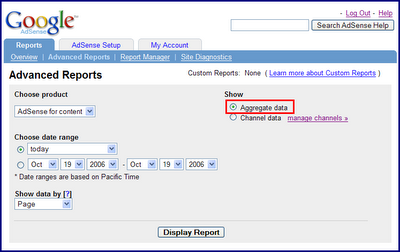
Now get tracking (correctly)!
Posted by Laura Chen - AdSense Publisher Support
- Your ads are being tracked on multiple URL channels.
Let's say you've set up 2 URL channels - one to track example.com and to track www.example.com/page. The URL channel example.com will track clicks and impressions from all subdomains, subdirectories, and subpages of example.com. As a result, one click on www.example.com/page will be tracked on both of your URL channels, which means you'll see two clicks recorded in your channel reports. However, your aggregate reports will show you the correct number of clicks, one, with no data duplication. You can learn more about how URL channels will track specific pages in our Help Center. - Your ads are being tracked on both a URL and a custom channel.
Now let's suppose you have a URL channel for example.com and a custom channel called Example Homepage, which you're using on the homepage of example.com. When you receive a click on the ad unit tagged with your Example Homepage custom channel, it will also be tracked on your example.com URL channel. Just like above, this means that you'll see two clicks logged in your channel reports, but only one in your aggregate reports. - Your ads are being tracked on multiple custom channels.
So you've taken advantage of our new feature, and you're tracking each of your red leaderboards with 2 custom channels -- one called Red_ad_units and one called Leaderboards. One click on a red leaderboard will be tracked in both of your custom channels, so you'll see twice as much data when you compare your channel reports to your aggregate reports.

Now get tracking (correctly)!
Posted by Laura Chen - AdSense Publisher Support
Tuesday, 17 October 2006
All the elements for a successful optimisation
Many of you might remember our April post featuring Ivan Heneghan, a member of the AdSense UK Optimisation Team. Ivan discussed a science website that was able to dramatically increase AdSense earnings through a few simple changes. Well, Ivan's back to share more details about that story with you:
When UK-based WebElements.com started using AdSense in late 2003, their earnings averaged out at a low daily rate. In January 2005, WebElements began to focus on optimisation, experimenting with different ad colors, ad styles, and page locations. They found success by adding link units to each page of their site, placing Large Rectangles directly before and after their content, and adding a Wide Skycraper to their left sidebar.
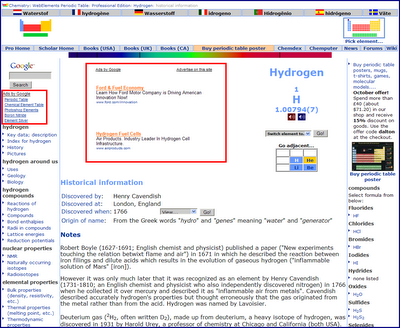
In the week following the optimisation, WebElements saw revenue increase by 500%. They then made other small placement changes to the site, which resulted in a spike doubling the revenue yet again -- as a result, the site was earning over 1000% its original earnings for some of the year.
Today, this ad revenue enables WebElements to further develop their site. The company advises that "it is important to experiment with colors, ad sizes, and locations on the page, as the audience for one type of web site may well respond to ads differently to another. It is worth experimenting with colors that blend with site design and others that show some contrast. It is also a good idea to use Adsense channels to run different color schemes in different channels at the same time and to wait for a week or so before deciding which colors work best. And, of course, content is king."
Posted by Ivan Heneghan - AdSense UK Optimisation Team
When UK-based WebElements.com started using AdSense in late 2003, their earnings averaged out at a low daily rate. In January 2005, WebElements began to focus on optimisation, experimenting with different ad colors, ad styles, and page locations. They found success by adding link units to each page of their site, placing Large Rectangles directly before and after their content, and adding a Wide Skycraper to their left sidebar.

In the week following the optimisation, WebElements saw revenue increase by 500%. They then made other small placement changes to the site, which resulted in a spike doubling the revenue yet again -- as a result, the site was earning over 1000% its original earnings for some of the year.
Today, this ad revenue enables WebElements to further develop their site. The company advises that "it is important to experiment with colors, ad sizes, and locations on the page, as the audience for one type of web site may well respond to ads differently to another. It is worth experimenting with colors that blend with site design and others that show some contrast. It is also a good idea to use Adsense channels to run different color schemes in different channels at the same time and to wait for a week or so before deciding which colors work best. And, of course, content is king."
Posted by Ivan Heneghan - AdSense UK Optimisation Team
Thursday, 12 October 2006
Introducing multiple custom channels
As of today, it is now possible to assign multiple custom channels to a single ad unit. This feature enables you to track your ad performance with greater flexibility and view more granular information. When generating your ad code, you'll be able to add up to 5 custom channels to a specific instance of ad code.

What's the benefit of tracking with more than one custom channel? Well, multiple channels can be very useful when you want to track one ad unit across several different metrics simultaneously. For example, let's say you run a sports website and you've placed a leaderboard at the top and bottom of every page. To track the performance of the ad placement, you've created two custom channels -- 'TopLeaderboard' and 'BottomLeaderboard' -- and regenerated your ad code appropriately.
But what if you also want to compare your football pages and your baseball pages at the same time? With multiple custom channels, this isn't a problem. Just create two new custom channels called 'FootballPages' and 'BaseballPages', and add them to the appropriate ad units. Now your leaderboards will each be tagged with two custom channels that let you know which position they're in (top or bottom), and the type of page on which they appear (football or baseball).
Please keep in mind that ad units tagged with multiple custom channels will log impressions or clicks in each channel. As a result, you'll see a higher number of impressions and clicks when you view your channel reports than when you view your aggregate reports.
If you'd like more information about setting up multiple channels, please visit our Help Center.
Posted by Arlene Lee - AdSense Publisher Support

What's the benefit of tracking with more than one custom channel? Well, multiple channels can be very useful when you want to track one ad unit across several different metrics simultaneously. For example, let's say you run a sports website and you've placed a leaderboard at the top and bottom of every page. To track the performance of the ad placement, you've created two custom channels -- 'TopLeaderboard' and 'BottomLeaderboard' -- and regenerated your ad code appropriately.
But what if you also want to compare your football pages and your baseball pages at the same time? With multiple custom channels, this isn't a problem. Just create two new custom channels called 'FootballPages' and 'BaseballPages', and add them to the appropriate ad units. Now your leaderboards will each be tagged with two custom channels that let you know which position they're in (top or bottom), and the type of page on which they appear (football or baseball).
Please keep in mind that ad units tagged with multiple custom channels will log impressions or clicks in each channel. As a result, you'll see a higher number of impressions and clicks when you view your channel reports than when you view your aggregate reports.
If you'd like more information about setting up multiple channels, please visit our Help Center.
Posted by Arlene Lee - AdSense Publisher Support
Wednesday, 11 October 2006
EFT available in three new countries
Are you a publisher located in the Czech Republic, Finland, or Slovakia? If so, we're happy to let you know that Electronic Funds Transfer (EFT) is now available to you. Sign up today to receive future payments directly in your bank account -- remember, the 15th of any month is the deadline to update your form of payment for that month's payment cycle. If you're having difficulty receiving your test deposit, you might find our troubleshooting tips useful.
Posted by Alexa Bruce - AdSense Publisher Support
Posted by Alexa Bruce - AdSense Publisher Support
Tuesday, 10 October 2006
Go go Google Gadgets
Wouldn't it be great to get your content in front of people while they're visiting Google.com or other webpages? More eyeballs on your site means more opportunities for your content to reach visitors, along with, of course, your AdSense ads. Google Gadgets enables you to do just that.
Gadgets are miniature devices that offer cool, dynamic content ranging from games to news clips to weather reports to just about anything you can dream up. They've been around for a while, but their reach got a lot broader last week when we made it possible for anyone to add gadgets to their own webpages. That means you! Here's an example of a flight status tracker, for instance, that can be placed on any page on the web.

You can search for free gadgets to add to your own webpages in our directory of gadgets for your webpage. To display a gadget, just pick the one you like, set your preferences, click "Get code," and copy-and-paste the HTML onto your own page. Add some 'bling' to your site and 'wow' your readers!
Creating Google Gadgets from your own content for others to use isn't hard, either -- anyone with even a bit of web design experience can make a simple one in HTML, and more advanced programmers can create really snazzy complex applications. But remember, it’s also quick and easy for people to delete gadgets and add new ones to their own pages. To help you make sure your gadget will be popular across the web, we provide a few guidelines to keep in mind. The more valuable visitors find your content, the longer they'll keep your gadget on their pages, the more often they’ll visit your site -- and the better that can be for your AdSense performance.
Here are a few other suggestions for successfully distributing your own content on the Google homepage or other pages across the web:
Posted by Samantha Crow - Product Marketing for Google Gadgets
Gadgets are miniature devices that offer cool, dynamic content ranging from games to news clips to weather reports to just about anything you can dream up. They've been around for a while, but their reach got a lot broader last week when we made it possible for anyone to add gadgets to their own webpages. That means you! Here's an example of a flight status tracker, for instance, that can be placed on any page on the web.

You can search for free gadgets to add to your own webpages in our directory of gadgets for your webpage. To display a gadget, just pick the one you like, set your preferences, click "Get code," and copy-and-paste the HTML onto your own page. Add some 'bling' to your site and 'wow' your readers!
Creating Google Gadgets from your own content for others to use isn't hard, either -- anyone with even a bit of web design experience can make a simple one in HTML, and more advanced programmers can create really snazzy complex applications. But remember, it’s also quick and easy for people to delete gadgets and add new ones to their own pages. To help you make sure your gadget will be popular across the web, we provide a few guidelines to keep in mind. The more valuable visitors find your content, the longer they'll keep your gadget on their pages, the more often they’ll visit your site -- and the better that can be for your AdSense performance.
Here are a few other suggestions for successfully distributing your own content on the Google homepage or other pages across the web:
- If your website has a feed, visitors can put snippets of your content on their own Google homepages quickly and easily -- you won't even need to develop a gadget. However, you'll be able to customize your visitors' experience much more with a gadget than with a feed.
- By putting the "Add to Google" button in a prominent spot on your site, you can increase the reach of your content, because visitors who click to add your gadget or feed to Google can see your content each time they visit the Google homepage. Promoting your own gadget or feed can also increase its popularity, which contributes to a higher ranking in the Google personalized homepage directory.
Posted by Samantha Crow - Product Marketing for Google Gadgets
Thursday, 5 October 2006
Forums? For me?
At the beginning of September, we announced that AdSense Help Forums were available in English, German, and Chinese. We’re happy to add two more forums to that list: AdSense ヘルプ フォーラム for our Japanese-speaking publishers, and Fórum do AdSense for our Portuguese-speaking publishers.
Are you looking for advice on how to set up your channels or optimize your site? Would you like to ask other publishers who live in your region how long it usually takes them to receive their checks? If you'd like to discuss anything AdSense, our Help Forums are the place to be -- visit today to post your questions!
Posted by Arlene Lee - AdSense Publisher Support
Are you looking for advice on how to set up your channels or optimize your site? Would you like to ask other publishers who live in your region how long it usually takes them to receive their checks? If you'd like to discuss anything AdSense, our Help Forums are the place to be -- visit today to post your questions!
Posted by Arlene Lee - AdSense Publisher Support
Wednesday, 4 October 2006
The missing link
Even if your site is well-designed, with colors that look great and ad formats that your users respond well to, you still might hear a nagging voice inside your head that says, "There must be more I can do!" If this sounds familiar, then we've got a cure -- link units work wonders when you're looking for additional ways to give your AdSense performance a pick-me-up. They offer your users fresh, new content and can be customized and tracked just like standard text ads.
If the voice in your head is still there, it's likely asking, "Where should I place link units on my pages?" Here are some ideas to get the ball rolling:

Link units proved to be the missing link for several of our publishers- you might remember reading about how Engineeringtalk, Ask The Builder, and PCFreunde saw their AdSense earnings soar after adding link units to their pages.
With 12 different sizes, you're bound to find a size that fits snugly into those "hard to reach" areas of your site.
Posted by Christine Lee - AdSense Product Marketing
If the voice in your head is still there, it's likely asking, "Where should I place link units on my pages?" Here are some ideas to get the ball rolling:
- Above or below a navigation menu or site search box -- but remember to keep your link units distinct
- Above the fold, at the beginning of pages with more focused content where people may be seeking specific information (article pages, category-level pages)
- In prime spots as designated by our heat map

Link units proved to be the missing link for several of our publishers- you might remember reading about how Engineeringtalk, Ask The Builder, and PCFreunde saw their AdSense earnings soar after adding link units to their pages.
With 12 different sizes, you're bound to find a size that fits snugly into those "hard to reach" areas of your site.
Posted by Christine Lee - AdSense Product Marketing
Tuesday, 3 October 2006
Spotlight on... TakeABreak.com.au
To continue the Australian theme from last week's post, we'd like to share a recent case study which focuses on an Australian publisher. Craig Davis, General Manager of TakeABreak.com.au, saw an increase of 30% in his AdSense revenue after he changed his layouts and introduced image ads. Now, AdSense revenue makes up about 10% of his company's overall revenue. Craig noted that AdSense was "a key element that helped us to move quickly from just another start-up to a leader in the online accommodation industry."
Read more about Craig's story here.

Posted by Julian Sonego - Country Marketing Manager for Australia
Read more about Craig's story here.

Posted by Julian Sonego - Country Marketing Manager for Australia
Thursday, 28 September 2006
Embed and enjoy
Over the past few months, we've drawn attention to the value of video, and specifically, of embedding video on your sites. We're happy to announce that Google Video is now available for Australia!
Our Australian friends can search for the most popular videos in Australia and embed them on their own sites, all within a localized (or rather "localised") interface. Not only is there the usual treasure trove of footage uploaded by individual users already on Google Video, but the AU team has worked closely with great partners like ABC, AFTRS (the Australian Film, Television and Radio School), Channel 10, Film Australia, Fairfax and SonyBMG. We're sure you'll find some great content amongst these partners and others to enhance your website.
In addition, there are now many ways for you to customize the video player itself and the surrounding page. This way, the player is integrated with your content and will help engage your users. You can:
Posted by Julian Sonego - Country Marketing Manager for 'The Land Down Under'
Our Australian friends can search for the most popular videos in Australia and embed them on their own sites, all within a localized (or rather "localised") interface. Not only is there the usual treasure trove of footage uploaded by individual users already on Google Video, but the AU team has worked closely with great partners like ABC, AFTRS (the Australian Film, Television and Radio School), Channel 10, Film Australia, Fairfax and SonyBMG. We're sure you'll find some great content amongst these partners and others to enhance your website.
In addition, there are now many ways for you to customize the video player itself and the surrounding page. This way, the player is integrated with your content and will help engage your users. You can:
- Resize the player to fit the design of your site by editing the pixel width and height
- Set the player to autoplay on page load, or start playing at a specific point in the video
- Get creative in the way you design the area surrounding the player (there's a great example here)
Posted by Julian Sonego - Country Marketing Manager for 'The Land Down Under'
Tuesday, 26 September 2006
Focus on your content -- we'll do the rest
Provide a great user experience, and the money will follow. We've found this to be true time and time again with our own products and services. For publishers like you, this starts with offering content that's meaningful to your visitors. The more you can focus on your core asset -- your site's content -- the more successful you can be with AdSense.
We just launched a service that can help you spend less time, energy, and money on one of the biggest distractions for publishers: maintaining IT systems. Google Apps for Your Domain lets you offer powerful communication and collaboration tools including Gmail, Google Calendar and Google Talk to everyone with an account on your own domain, people within your organization and/or members of your community. You can private-label the interfaces to make them your own, and best of all, everything is managed on Google's scalable, secure systems, just like AdSense. No servers to install or maintain, no spam upgrades to think about, and no special software required.
And sticking with our own credo to focus on the user experience above all else, Google Apps for Your Domain is free. Learn more and get started here.
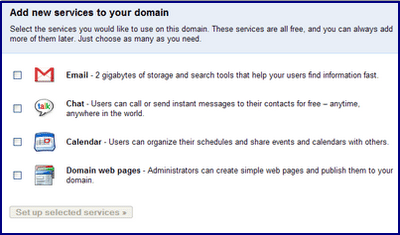
Posted by Jeremy Milo - Product Marketing Manager for Google Apps for Your Domain
We just launched a service that can help you spend less time, energy, and money on one of the biggest distractions for publishers: maintaining IT systems. Google Apps for Your Domain lets you offer powerful communication and collaboration tools including Gmail, Google Calendar and Google Talk to everyone with an account on your own domain, people within your organization and/or members of your community. You can private-label the interfaces to make them your own, and best of all, everything is managed on Google's scalable, secure systems, just like AdSense. No servers to install or maintain, no spam upgrades to think about, and no special software required.
And sticking with our own credo to focus on the user experience above all else, Google Apps for Your Domain is free. Learn more and get started here.
Posted by Jeremy Milo - Product Marketing Manager for Google Apps for Your Domain
Monday, 25 September 2006
Unlocking the relationship between CTR and earnings
Here's an AdSense mystery worthy of intrepid detective Veronica Mars: Why are increases in clickthrough rate (CTR) sometimes accompanied by decreases in earnings per click?
Occasionally, we hear from publishers who are perplexed that their earnings don't change despite an increase in CTR. This phenomenon can seem inexplicable, and when it happens, publishers may suspect that 'smart pricing' has taken effect, or that Google is making revenue share changes. What's really going on?
AdSense is unique because it's designed to maximize eCPM for our publishers, taking into account both the advertiser's cost-per-click (CPC) bid and the likelihood that the ad will be clicked. Some ads are attractive to a broad range of site visitors and will be clicked on more frequently. While this can be great for your CTR, advertisers are often bidding less for these kinds of broadly targeted ads. Other ads are attractive only to a small niche of users. Advertisers will typically pay more for these tightly targeted ads, but those ads are also less likely to get clicked.
Depending on ad inventory, you may see some days on which AdSense will show a lot of high CTR/low CPC variety ads. On other days, you may see the reverse. If you see this correlation in your own AdSense reports, keep in mind that we're always working hard to maximize revenue for our publishers. One aspect of that is being able to best take advantage of the earnings characteristics of different kinds of ads.
Posted by Bryan Vu - AdSense Optimization Team
Occasionally, we hear from publishers who are perplexed that their earnings don't change despite an increase in CTR. This phenomenon can seem inexplicable, and when it happens, publishers may suspect that 'smart pricing' has taken effect, or that Google is making revenue share changes. What's really going on?
AdSense is unique because it's designed to maximize eCPM for our publishers, taking into account both the advertiser's cost-per-click (CPC) bid and the likelihood that the ad will be clicked. Some ads are attractive to a broad range of site visitors and will be clicked on more frequently. While this can be great for your CTR, advertisers are often bidding less for these kinds of broadly targeted ads. Other ads are attractive only to a small niche of users. Advertisers will typically pay more for these tightly targeted ads, but those ads are also less likely to get clicked.
Depending on ad inventory, you may see some days on which AdSense will show a lot of high CTR/low CPC variety ads. On other days, you may see the reverse. If you see this correlation in your own AdSense reports, keep in mind that we're always working hard to maximize revenue for our publishers. One aspect of that is being able to best take advantage of the earnings characteristics of different kinds of ads.
Posted by Bryan Vu - AdSense Optimization Team
Friday, 22 September 2006
Designers are hard at work, and so are we
In honor of Fashion Week, this Saturday, AdSense will be workin' it out. No, not on the runway -- we'll be doing regular system maintenance from 10am-2pm PST. Even AdSense needs its beauty rest! ;)
You won't be able to access your account during this time, but don't worry, dahling - we'll keep serving those fabulous ads and recording all those stunning impressions they make on your visitors.
Posted by Julie Beckmann - AdSense Publisher Support
You won't be able to access your account during this time, but don't worry, dahling - we'll keep serving those fabulous ads and recording all those stunning impressions they make on your visitors.
Posted by Julie Beckmann - AdSense Publisher Support
Thursday, 21 September 2006
New channels page, new ad format
This week we bring you two key improvements to AdSense that came about directly from publisher feedback.
First off, you'll be happy to hear that we've completely revamped the Channels page under your AdSense Setup tab. Besides cleaning up the design by housing each product on its own sub-tab, we've also made it easier for you to take action on your channels. Just select the checkbox next to a channel and then choose to activate, deactivate, remove, or rename the channel you've selected. You can also find more information about getting started with channels in our Help Center.
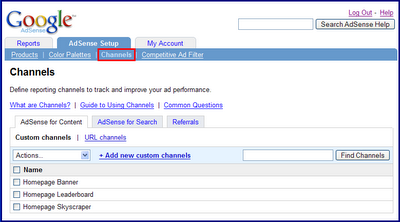
We're also launching the new 200 x 200 size ad format, better known as the small square. This ad format supports text, image and video ads, and we hope that you'll find it a useful option when integrating your ads into your site.
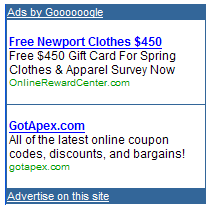
If you have other suggestions for future product features, we'd love to hear them!
Posted by Nikhil Achwal - AdSense Publisher Support
First off, you'll be happy to hear that we've completely revamped the Channels page under your AdSense Setup tab. Besides cleaning up the design by housing each product on its own sub-tab, we've also made it easier for you to take action on your channels. Just select the checkbox next to a channel and then choose to activate, deactivate, remove, or rename the channel you've selected. You can also find more information about getting started with channels in our Help Center.
We're also launching the new 200 x 200 size ad format, better known as the small square. This ad format supports text, image and video ads, and we hope that you'll find it a useful option when integrating your ads into your site.
If you have other suggestions for future product features, we'd love to hear them!
Posted by Nikhil Achwal - AdSense Publisher Support
Tuesday, 19 September 2006
Video post: Want search results?
A few weeks ago, we told you that publishers can display AdSense for search results within their own sites. Now AdSense Product Manager Shirin Oskooi explains the benefits and provides a short demonstration in this video.
Interested in implementing search results within your own site? Just visit our Help Center for instructions.
Posted by Dobromir Montauk - AdSense Publisher Support
Interested in implementing search results within your own site? Just visit our Help Center for instructions.
Posted by Dobromir Montauk - AdSense Publisher Support
Monday, 18 September 2006
Inside AdSense launches in Portuguese
We're excited to let you know about the launch of a new AdSense blog: Portuguese-speaking publishers can now read the latest AdSense news and announcements at Por Dentro do AdSense: o blog oficial do AdSense em português.
From São Paulo and Dublin, the AdSense Portuguese team supports publishers in countries including Angola, Brazil, Cape Verde, East Timor, and of course Portugal. The new blog will feature local case studies and information just for Portuguese-speaking publishers, as well as optimization tips and feature updates to help you make the most of your AdSense account.
Subscribe to the new blog today and start receiving posts directly in your inbox!
Posted by the AdSense Portuguese blog team
From São Paulo and Dublin, the AdSense Portuguese team supports publishers in countries including Angola, Brazil, Cape Verde, East Timor, and of course Portugal. The new blog will feature local case studies and information just for Portuguese-speaking publishers, as well as optimization tips and feature updates to help you make the most of your AdSense account.
Subscribe to the new blog today and start receiving posts directly in your inbox!
Posted by the AdSense Portuguese blog team
Wednesday, 13 September 2006
Got referral feedback? Speak up!
In March, we asked for your feedback on referrals. With the launch of our new button design and the option to display referrals in more products and languages, the referrals team would love to hear more from you. Feel free to give us any type of feedback – whether it's how we can further improve the referrals program, or if you've seen great success with the new button design. We always enjoy receiving mail from you!
Posted by Laura Chen - AdSense Publisher Support
Posted by Laura Chen - AdSense Publisher Support
Monday, 11 September 2006
Google Pack available internationally
We're happy to tell you that Pack referral buttons are now available in additional languagues such as German, Portuguese, and Japanese. Don't forget -- when a Windows user you've referred to Pack downloads and installs it for the first time, you'll receive up to US$2 in your account.

To begin displaying Pack referral buttons on your site, simply choose Referrals from the AdSense Setup page of your account, then select Pack as the product to which you'd like to refer users on your pages.
Posted by Laura Chen - AdSense Publisher Support
To begin displaying Pack referral buttons on your site, simply choose Referrals from the AdSense Setup page of your account, then select Pack as the product to which you'd like to refer users on your pages.
Posted by Laura Chen - AdSense Publisher Support
Thursday, 7 September 2006
Add fun, dynamic content without all the work
I'd like to share this earth-shattering news with you: David Hasselhoff (of Knight Rider and Baywatch fame) has come out with a classic new music video that should not be missed. How did I find out about it? I saw a dynamically generated link to it from Google Related Links at the bottom of my blog. (And I've found some other gems that way that have to wait for another post.)
Let me give you what the MBAs call the 8-second elevator pitch (our buildings are not very tall around here) on Google Related Links. The idea is you surf over to http://www.google.com/relatedlinks/ and start creating a Google Related Links unit for your site. You pick the color, size, and types of content (related news, videos, searches, web pages) that you want to appear in this Related Links unit, and then copy the JavaScript over to your site just as you would do for an AdSense ad unit. Google crawlers will then crawl your site, see what type of content is there, and then dynamically show links in the unit that relate to your site.
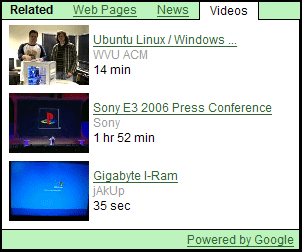
While Google Related Links don't give you revenue directly, you can use them to keep your site fresh and interesting without any maintenance. Happy visitors mean repeat visits. And if you're feeling especially creative, try alternating between Google ads and Google Related Links in a given space on your page. This will encourage people to look in that space for interesting dynamic content.
Oh, and by the way, you're more than welcome to click the links in a Google Related Links unit on your own site. Happy surfing!
Posted by Shannon Bauman - Product Manager for Google Related Links
Let me give you what the MBAs call the 8-second elevator pitch (our buildings are not very tall around here) on Google Related Links. The idea is you surf over to http://www.google.com/relatedlinks/ and start creating a Google Related Links unit for your site. You pick the color, size, and types of content (related news, videos, searches, web pages) that you want to appear in this Related Links unit, and then copy the JavaScript over to your site just as you would do for an AdSense ad unit. Google crawlers will then crawl your site, see what type of content is there, and then dynamically show links in the unit that relate to your site.
While Google Related Links don't give you revenue directly, you can use them to keep your site fresh and interesting without any maintenance. Happy visitors mean repeat visits. And if you're feeling especially creative, try alternating between Google ads and Google Related Links in a given space on your page. This will encourage people to look in that space for interesting dynamic content.
Oh, and by the way, you're more than welcome to click the links in a Google Related Links unit on your own site. Happy surfing!
Posted by Shannon Bauman - Product Manager for Google Related Links
Wednesday, 6 September 2006
The AdSense Help Forum -- now in Deutsch and 中文
As membership in the English AdSense Help Forum crosses the 4,500 mark, we're very pleased to announce the launch of two new Help Forums: AdSense 支持论坛 in Chinese, and the AdSense Forum for German speakers.
In these communities, you can help other publishers optimize their sites, ask for troubleshooting advice, or just chat about AdSense features and your experiences with the program.
現在就向其他 AdSense 发布商学习吧!
Lernen Sie von anderen AdSense Publishern!
Posted by Jordan Blackthorne - AdSense Publisher Support
In these communities, you can help other publishers optimize their sites, ask for troubleshooting advice, or just chat about AdSense features and your experiences with the program.
現在就向其他 AdSense 发布商学习吧!
Lernen Sie von anderen AdSense Publishern!
Posted by Jordan Blackthorne - AdSense Publisher Support
Friday, 1 September 2006
Been laboring away?
Then take a rest this holiday! After working hard to optimize your site during the past month, it's time to take a break and enjoy the fruits of your efforts. Our U.S. offices will be taking a break this weekend as well, so you can expect that our responses to any messages you send us will take slightly longer to arrive. We'll be back, relaxed and rejuvenated, on Tuesday. If you're too excited about all the optimizations you've made to take it easy, then take some time to browse our Help Center or Help Discussion Forum over the long weekend.
Posted by Julie Beckmann - AdSense Publisher Support
Posted by Julie Beckmann - AdSense Publisher Support
Thursday, 31 August 2006
"Augtomize" year-round
It's hard to believe the month is already over. It seems like just yesterday when Mike Gutner first announced that August was Optimization Month. Since then, members of the AdSense optimization team and Googlers representing other products have shared their findings and best practices for how to optimize your AdSense earnings. We hope you've come through the month with an arsenal of insightful tips and tricks for optimizing not only your AdSense ads, but also your site content for your specific audience.
We'd like to leave you with the following:
Posted by Carolyn Bang - AdSense Optimization Team
We'd like to leave you with the following:
- Nothing warms the hearts of our team more than hearing success stories from AdSense publishers. Please tell us yours!
- The road to enlightenment begins with the Optimization Tips page. If you haven't seen it yet or it's been awhile, be sure to check it out.
- Teach a person to fish, and you feed them for a lifetime. The AdSense Help group is a great community to post optimization tips and swap best practices with other publishers.
Posted by Carolyn Bang - AdSense Optimization Team
Wednesday, 30 August 2006
Robert's tips for the future
1. Get accustomed to custom channels.
The single most effective way I've found for publishers to measure their results is by using custom channels. Custom channels are the ideal way to determine how a recent change in ad placement or ad format has resulted in improved performance. Many publishers fail to keep their custom channel list up to date each time they make a change -- or even worse, don't take the time to set them up at all. Not knowing if you've made the right decision for your site's visitors will make it even more difficult to take the next step, so use custom channels like a tracking device to ensure you're on the road to success.
2. Be analytical in your approach -- use Google Analytics.
Monitoring your AdSense performance need not be restricted to the features within your AdSense account. Learning about where your visitors come from and how they interact with your website will help you make informed decisions regarding ad placement and formats. As we mentioned last week, Google Analytics can help you make choices about improving your site design while incorporating the Adsense optimisation tips into your new layout. Measuring the results of such changes enables better decisions for your site's users, so why not measure your site performance with Analytics?
3. Make yourself available, your reports are now emailable.
If you're serious about measuring how your account is performing, you'll need to keep up to date with your reports. Why spend time trawling through data in your account when you can get it all sent directly to your inbox? Emailable reports are a recent addition to your AdSense account, which give you exactly the data you're interested in on a daily, weekly or monthly basis. What's more, you can send them to multiple email addresses. This way, you can keep your business partner up to date on recent successes. Emailable reports are easy to set up and even easier to access, with one click in your inbox. If you're not using this option already, I encourage you to to set up emailable reports today to monitor the effects of your changes straight away.
Posted by Robert Freeborn – AdSense UK Optimization Team
Tuesday, 29 August 2006
Back to school basics
The “back to school” buzz is in the air, and just as it was key to organize your papers in middle school using your trusty Trapper Keeper, it’s important to manage your ads using your AdSense data. Doing so lets you to see the effectiveness of the different implementations you’ve tested out this month and make decisions about next steps. So let’s flash back to the good old days and apply what we learned in middle school.
Vocabulary: Understanding your data
Before you could use a new word from your vocabulary textbook, you needed to understand its definition. Similarly, there are several important statistical values on your Advanced Reports page for which you should know the definitions before doing any analysis. I recommend that you check out our glossary for each of the terms (Page Impression, eCPM, Clicks) to understand how these values are affected by the changes you make to your site.
Foreign languages: Translating your data
Learning a foreign language involves taking a great deal of new information and breaking it down into sizeable chunks to interpret it. As we mentioned in a previous post, URL and custom channels are a great way to take a more granular look at your site and track specific implementation changes you’ve made.
It’s also necessary to create an appropriate measurement for your data. Too much is confusing, and too little is not going to give you accurate results. Normally, good measurements include 30-, 60- and 90-day increments.
Finally, you’ll need to analyze the data. A great feature we offer is the CSV link, which enables you to download your data onto your hard drive so you can rearrange it to your specific needs. I recommend using Google Spreadsheets or Excel.
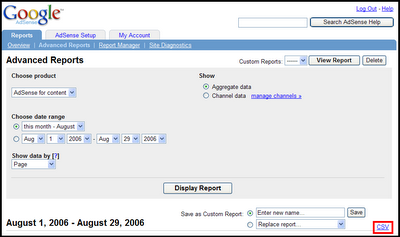
Art appreciation: Displaying your data
As your art teacher used to say, a picture is worth a thousand words. Staring at raw data can be tedious and won't help you visualize trends in your AdSense stats. This is why tables and graphs are so effective. A table can make your data more comprehensive and easier to read, while a graph helps you to observe visually what's happening to your various values. If you notice that one channel is performing better than another over a set period, it may be time to implement the same changes into your other pages.
Tip: Track the various implementation changes you’ve made on a separate sheet, and note the date. You can then review those dates later and compare them with previous sets of data to discover which changes had the greatest impact on your site.
Quarterly report card
I recommend that you perform this type of analysis every 3 months to ensure that you are optimizing your site to its potential. By tracking and managing your data, you will be on your way to becoming a more savvy AdSense user. And of course, don’t forget to thank your 7th grade teacher for imparting this knowledge.
Posted by Sunil Subhedar - AdSense Optimization Team
Vocabulary: Understanding your data
Before you could use a new word from your vocabulary textbook, you needed to understand its definition. Similarly, there are several important statistical values on your Advanced Reports page for which you should know the definitions before doing any analysis. I recommend that you check out our glossary for each of the terms (Page Impression, eCPM, Clicks) to understand how these values are affected by the changes you make to your site.
Foreign languages: Translating your data
Learning a foreign language involves taking a great deal of new information and breaking it down into sizeable chunks to interpret it. As we mentioned in a previous post, URL and custom channels are a great way to take a more granular look at your site and track specific implementation changes you’ve made.
It’s also necessary to create an appropriate measurement for your data. Too much is confusing, and too little is not going to give you accurate results. Normally, good measurements include 30-, 60- and 90-day increments.
Finally, you’ll need to analyze the data. A great feature we offer is the CSV link, which enables you to download your data onto your hard drive so you can rearrange it to your specific needs. I recommend using Google Spreadsheets or Excel.
Art appreciation: Displaying your data
As your art teacher used to say, a picture is worth a thousand words. Staring at raw data can be tedious and won't help you visualize trends in your AdSense stats. This is why tables and graphs are so effective. A table can make your data more comprehensive and easier to read, while a graph helps you to observe visually what's happening to your various values. If you notice that one channel is performing better than another over a set period, it may be time to implement the same changes into your other pages.
Tip: Track the various implementation changes you’ve made on a separate sheet, and note the date. You can then review those dates later and compare them with previous sets of data to discover which changes had the greatest impact on your site.
Quarterly report card
I recommend that you perform this type of analysis every 3 months to ensure that you are optimizing your site to its potential. By tracking and managing your data, you will be on your way to becoming a more savvy AdSense user. And of course, don’t forget to thank your 7th grade teacher for imparting this knowledge.
Posted by Sunil Subhedar - AdSense Optimization Team
Monday, 28 August 2006
Optimization Month, Week 5: Putting it all together
Now that you’ve implemented some of our optimization tips and best practices, hopefully your revenue is on the rise. But what if you see ups and downs in your stats? Never fear -- it’s quite common for revenue to fluctuate over time for any number of reasons, like which ads your users click on, or changes in ad inventory.
Seasonality can also affect revenue. If you run a fan site for a TV show, you might see a drop in revenue after the season finale due to a reduction in advertiser inventory or a decrease in the number of site targeting campaigns. Or, if you run an education site, you may see revenue decline during the summer vacation due to decreased page views. This is completely normal, and things will bounce back.
It’s crucial to keep these normal cyclical changes in mind when evaluating your stats. It’s also important to compare apples to apples. For instance, be sure you’re comparing days or months that received a similar number of page views. This will ensure that you are making accurate data comparisons. Using custom channels will also help you compare ad unit statistics at a very granular level to determine exactly which units are performing well, and which need to be modified or moved in order to boost CTR and eCPM.
Finally, if you’re interested in learning more about innovative strategies other successful publishers have used, check out some of our case studies.
Remember that every site is unique, so it’s critically important to keep testing and experimenting to see what performs the best for your own site. Don’t be afraid to try new things! And finally, I leave you with the following words of wisdom: Duct tape is like The Force -- it has a Light side and a Dark side and it holds the universe together.
Posted by Chrissie Kawasaki - AdSense Optimization Team
Friday, 25 August 2006
Maintenance on Saturday, August 26, at 10 am PDT
We interrupt your regularly scheduled Optimization Month posts to bring you this update: Our engineers will be performing routine system maintenance on Saturday (8/26) from 10 am to 2 pm PDT, so you won't be able to access your account during this time frame. Please be assured that ads will continue to be served to your pages, and your account statistics and earnings will be recorded as usual. In the meantime, feel free to go back and review all the great tips our optimization specialists have posted on the blog this month.
As always, we appreciate your patience!
Posted by Arlene Lee - AdSense Optimization Team
As always, we appreciate your patience!
Posted by Arlene Lee - AdSense Optimization Team
Insight into your site
We hope you've gained insight into the various tools and products Google has to offer for increasing the visibility of your site. As Boyar promised, we’ll close out this week's theme a little differently, by sharing with you the story of a publisher who used a number of Google products to increase his site's audience 50-fold in just two months.
Ryan, webmaster for TropicalYarns.com, had been using AdSense for content and AdSense for search to monetize his pages. However, he noticed that his site’s visitors consisted mainly of existing customers. Using Analytics, he was able to better understand his new and returning visitors. After pinpointing the most popular page on his site in June, he added an email newsletter sign-up form to that page and saw the subscription list grow by 20%. In just one month, he watched new visitors grow to 75% of his audience.

At the same time, Ryan used AdWords to advertise his site’s offerings. After experimenting for three weeks to optimize his ads, he was able to achieve a higher clickthrough rate and bring more engaged users to his site; in July, 14% of his site’s visitors arrived via an AdWords ad, and these visitors made up 22% of pageviews for the month. Plus, by using his Analytics reports to determine the search keywords which brought users to his site, he was able to make informed decisions about his ads. For example, because the search phrase "free patterns" drove organic traffic to his site, he knew he didn’t need to run ads for that phrase.
Since Tropical Yarns is a retail store, Ryan also decided to experiment with products such as Google Base and Google Checkout. By listing more than 1,000 products on Base and offering customers a way to purchase them online, Ryan reached out to new users; although the store is located in South Florida, interested buyers from all over the United States can now visit the site to make purchases.
Recently, Ryan has been experimenting with Google Video to engage users on his site – future plans include a short commercial for the store, videos of classes, and more. Ryan's story serves as a great example of how you can improve your site's content and visibility through many Google products.
When asked about his overall experience, Ryan commented that "one by one, each of the dozen Google products we used has increased awareness of our website and helped to drive more quality traffic. No single item was overnight magic, but doing them all has proved to be a huge success!"
Posted by Arlene Lee - AdSense Optimization Team
Ryan, webmaster for TropicalYarns.com, had been using AdSense for content and AdSense for search to monetize his pages. However, he noticed that his site’s visitors consisted mainly of existing customers. Using Analytics, he was able to better understand his new and returning visitors. After pinpointing the most popular page on his site in June, he added an email newsletter sign-up form to that page and saw the subscription list grow by 20%. In just one month, he watched new visitors grow to 75% of his audience.
At the same time, Ryan used AdWords to advertise his site’s offerings. After experimenting for three weeks to optimize his ads, he was able to achieve a higher clickthrough rate and bring more engaged users to his site; in July, 14% of his site’s visitors arrived via an AdWords ad, and these visitors made up 22% of pageviews for the month. Plus, by using his Analytics reports to determine the search keywords which brought users to his site, he was able to make informed decisions about his ads. For example, because the search phrase "free patterns" drove organic traffic to his site, he knew he didn’t need to run ads for that phrase.
Since Tropical Yarns is a retail store, Ryan also decided to experiment with products such as Google Base and Google Checkout. By listing more than 1,000 products on Base and offering customers a way to purchase them online, Ryan reached out to new users; although the store is located in South Florida, interested buyers from all over the United States can now visit the site to make purchases.
Recently, Ryan has been experimenting with Google Video to engage users on his site – future plans include a short commercial for the store, videos of classes, and more. Ryan's story serves as a great example of how you can improve your site's content and visibility through many Google products.
When asked about his overall experience, Ryan commented that "one by one, each of the dozen Google products we used has increased awareness of our website and helped to drive more quality traffic. No single item was overnight magic, but doing them all has proved to be a huge success!"
Posted by Arlene Lee - AdSense Optimization Team
Thursday, 24 August 2006
Google Analytics hearts AdSense publishers
As an AdSense publisher, you've probably put a lot of effort into making your website the best it can be -- optimizing your ads, building good content, and driving high quality visits. But there's one crucial step left: to see just how effective these things are. How many visitors are you getting each day? What pages are they visiting? Where do they come from, and which keywords brought them to your site -- both from pay-per-click efforts and from natural search?
Many website owners push their site live, and then leave it at that, remaining in the dark about all these questions. Google Analytics can enlighten you. We think it's much more fun to have the answers to these burning questions, and that you owe it to yourself to know for sure. After all, this is the payoff for all the hard work that's gone into creating your site. When you launch or make a change to it, there's that initial excitement of wondering who's going to check it out. And Google Analytics can help you with all of this.
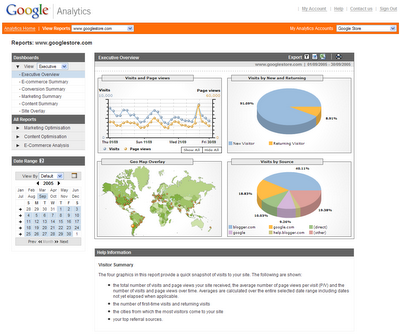
It's as easy to set up as AdSense. All you need to do is add a couple lines of code to each page in your site, and to gain valuable insight with graphical representations of visitor levels and detailed, easy-to-use reports that show:
Happy tracking!
Posted by Jeff Gillis - Product Marketing for Google Analytics
Many website owners push their site live, and then leave it at that, remaining in the dark about all these questions. Google Analytics can enlighten you. We think it's much more fun to have the answers to these burning questions, and that you owe it to yourself to know for sure. After all, this is the payoff for all the hard work that's gone into creating your site. When you launch or make a change to it, there's that initial excitement of wondering who's going to check it out. And Google Analytics can help you with all of this.
It's as easy to set up as AdSense. All you need to do is add a couple lines of code to each page in your site, and to gain valuable insight with graphical representations of visitor levels and detailed, easy-to-use reports that show:
- pageviews of each of individual web pages
- the average time spent on each page
- new vs. returning visitors
- visitors' geographical location and language
- their browser and platform choices
- click path data
Happy tracking!
Posted by Jeff Gillis - Product Marketing for Google Analytics
Wednesday, 23 August 2006
Just a click away
You're an AdSense publisher, and you've got great content, but you want a) more people to know about it and b) your loyal readers to know when you post new content so they can visit your site easily -- maybe by the click of a button. By building up traffic, you can get more eyeballs on your content and of course your AdSense ads. This is where Google Toolbar comes in.
There's more to Toolbar than just web search, pop-up blocking and auto-filling web forms. With the recent release of Google Toolbar 4, millions of Toolbar users are now adding custom buttons directly to their browsers. You can help users visit your site (and more) with just a click.

By adding your website's custom button to the Google Toolbar, people can instantly:
Posted by Joyce Sohn - Toolbar Product Marketing Manager
There's more to Toolbar than just web search, pop-up blocking and auto-filling web forms. With the recent release of Google Toolbar 4, millions of Toolbar users are now adding custom buttons directly to their browsers. You can help users visit your site (and more) with just a click.
By adding your website's custom button to the Google Toolbar, people can instantly:
- Visit your website
- Search your website by entering a query into the Google search box and clicking your custom button
- Get the latest feeds from your website by clicking the drop-down menu next to your custom button
Posted by Joyce Sohn - Toolbar Product Marketing Manager
Tuesday, 22 August 2006
Be webmaster of your domain (or sub-domain)
If a tree falls in the forest and no one can hear it, does it make a sound? Even more perplexing: if you have a great, content-rich website and nobody visits it, is the content useful? Rather than debate this, I'd like to share with you five ways that Google webmaster tools can help you drive more users to your site and improve the visibility of the site content you've worked so hard to create.
1. Submit all of your pages to the Google index – for free.
By using Google Sitemaps to submit your URLs, you help Google's web crawler do a more complete and efficient job of crawling your site. Sitemaps enables you to submit all of your pages to the Google index, and it's particularly useful for making sure that we know about all dynamically generated URLs or pages that are not adequately linked to on your site. But please note: submitting a Sitemap will not guarantee inclusion or influence your PageRank, and isn't a replacement for creating compelling and useful content.
2. Find out how Google sees your site.
Once you've made sure we have access to your site, you can see the common words used to link to your pages and that are seen by Google. This allows you to see trends in your site's content, and can help you determine why you may be ranking for particular keywords. You can also see which page has the highest PageRank by month. Some site owners are surprised to find that this isn't always the home page. If an internal page has the highest PageRank, you might consider spending more time optimizing the ads there.
3. Diagnose potential problems.
We let you know if, and why, we're having trouble accessing your site or specific pages. If we can't crawl a page, we can't index it -- so fixing any errors we list can help improve your overall coverage. If the AdSense Site Diagnostics tool shows that you're blocking pages from MediaPartners-Google (the AdSense crawler), you can use the robots.txt analysis tool of Google webmaster tools to test changes to that file and make sure those changes allow access. You can also see what pages you are blocking from other Google bots -- this lets you experiment with changes to see how they would affect the crawl of your site.
4. Find out which queries drive traffic to your site.
Using Google webmaster tools, learn which Google queries created clickthroughs to your site and where you were positioned in the search results for that query. You can also view data for individual properties and countries as well. For instance, you can see the queries from users searching Google Images in the United States that returned your site in the results. You’ll only see properties and countries for which your site has data.
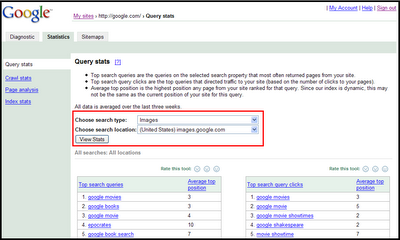
5. Get re-included.
If your site has disappeared from the search results, read through the Google quality guidelines, then correct any problems on your site and request re-inclusion from your Google webmaster tools account. Please keep in mind that the reinclusion request form is only available to people using Google webmaster tools.
There's more.
Google webmaster tools are evolving, and we frequently add more features. Stay up to date on the newest features with the Google Webmaster Central blog and get your questions answered on the Google Webmaster Help discussion group.
Here's to building a loyal following for your website and, in turn, optimizing your AdSense earnings!
Posted by Vanessa Fox - Product Manager for Google Webmaster Tools
1. Submit all of your pages to the Google index – for free.
By using Google Sitemaps to submit your URLs, you help Google's web crawler do a more complete and efficient job of crawling your site. Sitemaps enables you to submit all of your pages to the Google index, and it's particularly useful for making sure that we know about all dynamically generated URLs or pages that are not adequately linked to on your site. But please note: submitting a Sitemap will not guarantee inclusion or influence your PageRank, and isn't a replacement for creating compelling and useful content.
2. Find out how Google sees your site.
Once you've made sure we have access to your site, you can see the common words used to link to your pages and that are seen by Google. This allows you to see trends in your site's content, and can help you determine why you may be ranking for particular keywords. You can also see which page has the highest PageRank by month. Some site owners are surprised to find that this isn't always the home page. If an internal page has the highest PageRank, you might consider spending more time optimizing the ads there.
3. Diagnose potential problems.
We let you know if, and why, we're having trouble accessing your site or specific pages. If we can't crawl a page, we can't index it -- so fixing any errors we list can help improve your overall coverage. If the AdSense Site Diagnostics tool shows that you're blocking pages from MediaPartners-Google (the AdSense crawler), you can use the robots.txt analysis tool of Google webmaster tools to test changes to that file and make sure those changes allow access. You can also see what pages you are blocking from other Google bots -- this lets you experiment with changes to see how they would affect the crawl of your site.
4. Find out which queries drive traffic to your site.
Using Google webmaster tools, learn which Google queries created clickthroughs to your site and where you were positioned in the search results for that query. You can also view data for individual properties and countries as well. For instance, you can see the queries from users searching Google Images in the United States that returned your site in the results. You’ll only see properties and countries for which your site has data.
5. Get re-included.
If your site has disappeared from the search results, read through the Google quality guidelines, then correct any problems on your site and request re-inclusion from your Google webmaster tools account. Please keep in mind that the reinclusion request form is only available to people using Google webmaster tools.
There's more.
Google webmaster tools are evolving, and we frequently add more features. Stay up to date on the newest features with the Google Webmaster Central blog and get your questions answered on the Google Webmaster Help discussion group.
Here's to building a loyal following for your website and, in turn, optimizing your AdSense earnings!
Posted by Vanessa Fox - Product Manager for Google Webmaster Tools
Monday, 21 August 2006
Optimization Month, Week 4: Building and understanding your audience
[time passes]
Congratulations! Now your site is ready for all your eager users, but wait ... wouldn't it be great if more people knew about your site and could truly enjoy the fruits of your labor? Of course it would -- that's why this week we'll focus on tips and tricks to drive quality traffic to your site.
We've assembled a team of specialists across Google to enlighten you on the many Google products that can help you optimize your site traffic and content. I've no intention of stealing any of their fire, so I'll simply whet your appetites a bit...
And finally, to end the week we have something extra special. I won't ruin the surprise here, but suffice it to say that it'll be worth the wait.
- Find out about the many webmaster tools that can help you inform the Google crawlers about your site.
- Make your site available to millions of users at the click of a button.
- Learn more about your users, from the pages they're visiting most to the amount of time they spend on your site.
UPDATED for accuracy
Posted by Boyar Naito - AdSense Optimization Team
Friday, 18 August 2006
Christian's Tips: Getting the most out of AdSense
As a bonus, my advice will also help you climb the social ladder at your school or workplace. Prepare to grow your revenue...and your popularity.
1. Be friendly with everyone – If you want to be more popular in school, you can’t only get to know the drama students -- you have to make friends with the basketball team, the marching band, and the A/V club too. So many friends competing for your time makes it more valuable, just like more advertisers competing for your ad space makes it worth more. Without opting in to text, image, and video ads, you can't expect to get the most revenue possible for your ad space -- you need more advertisers competing in order to bid up the price of your ads. When the highest-paying advertiser wins, you do too!
2. Look your best – You don’t have to be a beauty queen or a male model to be popular, but you should present yourself as well as possible. To get the most out of AdSense, make your site attractive to advertisers spending site targeting dollars. As Natalie mentioned yesterday, site targeting revenue can have a big impact on your total earnings. When an advertiser checks out your site, let them see great formats, like the medium rectangle, in highly visible above-the-fold placements.
3. Be well rounded – In high school, being a talented football player or a skilled musician makes you interesting. But being a star quarterback who plays first violin, gets straight As, and still finds time to volunteer at the local soup kitchen makes you amazing. If you’re only successful with the standard AdSense ads, it’s time to expand. Try link units, referrals, and AdSense for search and track the results. You might be surprised what your next success will be.
I wish you the best of luck with these AdSense tips -- and hope that this new-found popularity doesn't go to your head!
Posted by Christian Ashlock - AdSense Optimization Team
Thursday, 17 August 2006
How to win advertisers and influence ad competition
UPDATE: Sorry, the Onsite Advertiser Sign-up feature is no longer available.
For today’s optimization tip, I'd like to focus on a site targeting feature: Onsite Advertiser Sign-up. This enables advertisers to quickly and easily target cost-per-impression (CPM) ads specifically to your site, from your site.
As a publisher, you'll be automatically opted in to Onsite Advertiser Sign-up. You can also customize the landing page advertisers will see when they click on the ‘Advertise on this site’ link within your ad units. This is your opportunity to market your site to advertisers, so don’t settle for the default description – this won’t convince advertisers why they should site target you. Write a sharp and compelling paragraph to engage advertisers and let them know what your site’s all about.
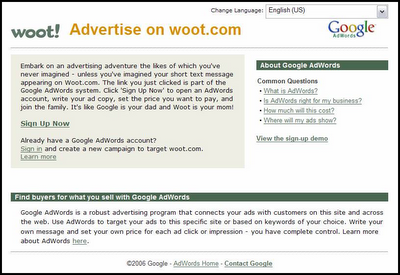
You'll benefit when more advertisers sign up to advertise on your site, since more competition among ads means more money for you. Just remember - keep it advertiser-friendly!
Posted by Natalie Avdeef - AdSense Optimization Team
For today’s optimization tip, I'd like to focus on a site targeting feature: Onsite Advertiser Sign-up. This enables advertisers to quickly and easily target cost-per-impression (CPM) ads specifically to your site, from your site.
As a publisher, you'll be automatically opted in to Onsite Advertiser Sign-up. You can also customize the landing page advertisers will see when they click on the ‘Advertise on this site’ link within your ad units. This is your opportunity to market your site to advertisers, so don’t settle for the default description – this won’t convince advertisers why they should site target you. Write a sharp and compelling paragraph to engage advertisers and let them know what your site’s all about.
You'll benefit when more advertisers sign up to advertise on your site, since more competition among ads means more money for you. Just remember - keep it advertiser-friendly!
Posted by Natalie Avdeef - AdSense Optimization Team
Wednesday, 16 August 2006
Search no further than your own site
If you haven't tried our AdSense for Search feature yet, now might just be the perfect time to put it to use -- we're pleased to announce that you can now display AdSense for search results within your own site. This way, you have the freedom to offer users web search while still maintaining the look and feel of your site. For example, you can keep elements like the header, footer, and site navigation panel the same for the search results page you create.
To use it, just choose the "Open results within my own site" radio button when you're generating your AdSense for search code. You'll also need to identify the page where you'd like to display your search results.

We'll give you two sets of code: one for the search box, and one for search results. Place the first set on a page where you'd like the search box to appear, and the second set on the page you'd like the search results to appear. Whenever users perform searches on your AdSense for search box, they'll be directed to the page on which you placed the search results code.
Since this new feature is part of AdSense for search, any Competitive Ad Filter and site-flavored search settings will still function as normal. You can also find detailed instructions for implementing this new option in our Help Center. Keep in mind that if you want your existing search boxes to take advantage of the new feature, you'll need to replace the search box code that's currently on your pages.
Posted by Nikhil Achwal - AdSense Optimization Team
To use it, just choose the "Open results within my own site" radio button when you're generating your AdSense for search code. You'll also need to identify the page where you'd like to display your search results.
We'll give you two sets of code: one for the search box, and one for search results. Place the first set on a page where you'd like the search box to appear, and the second set on the page you'd like the search results to appear. Whenever users perform searches on your AdSense for search box, they'll be directed to the page on which you placed the search results code.
Since this new feature is part of AdSense for search, any Competitive Ad Filter and site-flavored search settings will still function as normal. You can also find detailed instructions for implementing this new option in our Help Center. Keep in mind that if you want your existing search boxes to take advantage of the new feature, you'll need to replace the search box code that's currently on your pages.
Posted by Nikhil Achwal - AdSense Optimization Team
Tuesday, 15 August 2006
Referrals around the world
Back in May, we launched our new and improved referral buttons. Now these new buttons are available for additional products and languages. You can choose from several different colors and options, and the buttons are in a sleeker, web-friendly GIF format -- all the better to blend in with your site.
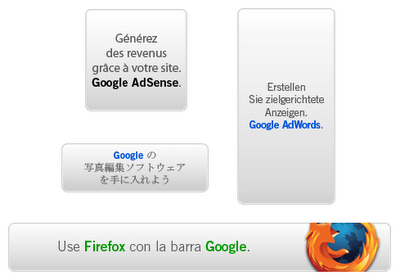
Publishers have found that it’s most beneficial to place referrals where they're relevant. Do you run a photo blog? Try using a Picasa referral button. Looking to boost revenue for your web hosting site? Implement a Firefox referral button and watch your earnings grow.
Don’t forget you can also implement referrals in a text link format. Text links easily integrate into your site and often convert better than buttons. Here are a few tips on generating more revenue with text links:
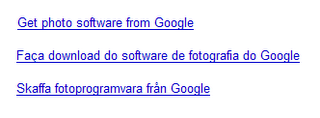
If you’re not already displaying referrals on your site, you may be missing out! Publishers have let us know that they’ve seen an increase in earnings since they implemented the feature. One publisher with a history-related site told us, “I get 3,000 uniques a day, and was only making about $15/day with regular AdSense for content. Today, I tried Firefox referrals and beside my regular site income, I've already made an extra $17.20 -- and the day isn't over yet.”
Not only will you benefit from the extra earnings, but your users will learn more about other products such as Picasa, Firefox, and AdWords. To begin displaying the new referral buttons, simply choose Referrals from the AdSense Setup page of your account, then select the product you'd like to refer users to on your pages.
Posted by Laura Chen - AdSense Optimization Team
Publishers have found that it’s most beneficial to place referrals where they're relevant. Do you run a photo blog? Try using a Picasa referral button. Looking to boost revenue for your web hosting site? Implement a Firefox referral button and watch your earnings grow.
Don’t forget you can also implement referrals in a text link format. Text links easily integrate into your site and often convert better than buttons. Here are a few tips on generating more revenue with text links:
- You can endorse products you've enjoyed using and encourage your users to do the same.
- Use text links to integrate the ad more seamlessly within your site content.
- Try having the text links inherit the font and look of your site, so they fit in with your current text style and size.
If you’re not already displaying referrals on your site, you may be missing out! Publishers have let us know that they’ve seen an increase in earnings since they implemented the feature. One publisher with a history-related site told us, “I get 3,000 uniques a day, and was only making about $15/day with regular AdSense for content. Today, I tried Firefox referrals and beside my regular site income, I've already made an extra $17.20 -- and the day isn't over yet.”
Not only will you benefit from the extra earnings, but your users will learn more about other products such as Picasa, Firefox, and AdWords. To begin displaying the new referral buttons, simply choose Referrals from the AdSense Setup page of your account, then select the product you'd like to refer users to on your pages.
Posted by Laura Chen - AdSense Optimization Team
Monday, 14 August 2006
Optimization Month, Week 3: The many features of AdSense
I’m glad you asked. AdSense isn't just ads; within your account, there are a number of features that you might never have noticed. This week we'll be focusing on some of these less-visible gems that can also contribute to revenue increases. As the saying goes, don't put all your ads in one basket. ;) Diversify with some other features!
Maybe your site is full of great content users will love (if only they can find what they're looking for) or maybe you're already using your own search model, but don't have a way to monetize it. In either case, AdSense for search is a great solution.
If your users are always looking for new products and services to try, and you're looking always looking for a new revenue stream, give referrals a gander.
Once your ads are visually appealing enough to catch the eye, they still need to catch your visitor's interest. You can use section targeting to emphasize the important parts of your content (of course it’s all important, but who are we kidding? Not all content is created equal).
You know your site is great. Advertisers know your site is great. Wouldn't it be great if they could easily target ads right to your site? They can, using Onsite Advertiser Sign-up.
We'll explore these features in more depth throughout the week, so be sure to check in again for more details.
Posted by Jeff Conkey - AdSense Optimization Team
Friday, 11 August 2006
Phoebe's ad design tips
I can understand throwing away a penny here and there, but it would be pretty ridiculous to toss out hundreds of dollars every day. This is how I feel about optimization. There are many simple ways to increase revenue, but publishers often overlook how easy it is to make changes. Take the case of one publisher, who tried changing his 468x60 banner to a 300x250 rectangle and saw his revenue double! Afterwards, of course, he regretted not making the change earlier.
My goal is to make sure you don't have the same regret when you realize you could have already made extra money -- if only you'd optimized sooner. So in order of "biggest bang for the buck," here goes:
1) Make sure your colors are appropriate for your site and ad location. It's the easiest change to make that can increase your revenue up to 4x!
2) When choosing formats, remember: "Wider is better." Though you always want to be sure the format fits into the space on your pages, use 160x600 instead of 120x600 and try using rectangles as much as you can. 336x280 and 300x250 are our best performing formats. And since they support image and video ads, you'll even have more advertisers bidding on these ad spaces than other formats.
3) Like Geoff said earlier this week, "Set your site on fire!". Make sure you place the ads where your users will see them. This is why "above the fold" is so popular, because most users will not scroll below the fold line. In the same way, people often look for menu bars on the left side of a page so ads in that location are "hot." If your design layout allows it, sandwich the ads with content: placing a rectangle in the middle of a long article not only helps your visitors read those ads, but it also gives them a visual break.
Just try these tips -- it may take you 5 minutes or an hour, but you'll never know until you do if they will make you even more money. What have you got to lose?
Posted by Phoebe Ho - AdSense Optimization Team
Thursday, 10 August 2006
Content is king
You already know that AdSense works by crawling your web pages for content, then delivering ads based on that content. This means that if your content is limited, our crawler may have difficulty identifying the information on the page. As a result, you may see ads that are not directly relevant to your page, or public service ads.
Here's a fix: Ensure that your pages are full of compelling content. The more targeted, full-text information you provide to our crawler, the easier it will be for our system to determine what your pages are about, and the greater the relevance of the Google ads will be. This enhances the effectiveness of the AdSense program, resulting in a better experience for your users, not to mention for the advertisers appearing on your pages.
Here’s a simple equation that spells it out:
The Google ads appearing on your site then serve as supplemental content, providing useful information to your users that pertains to the content you’ve worked so hard to develop. So help us help you -- optimize your page with good content.
UPDATED for accuracy
Posted by Mike Gutner - AdSense Optimization Team
Here's a fix: Ensure that your pages are full of compelling content. The more targeted, full-text information you provide to our crawler, the easier it will be for our system to determine what your pages are about, and the greater the relevance of the Google ads will be. This enhances the effectiveness of the AdSense program, resulting in a better experience for your users, not to mention for the advertisers appearing on your pages.
Here’s a simple equation that spells it out:
- A content-rich page = Highly-targeted ads
- Highly-targeted ads + Interested users = Healthy clickthrough & conversion rates
- Healthy clickthrough & conversion rates = Success!
The Google ads appearing on your site then serve as supplemental content, providing useful information to your users that pertains to the content you’ve worked so hard to develop. So help us help you -- optimize your page with good content.
UPDATED for accuracy
Posted by Mike Gutner - AdSense Optimization Team
Co-optimization: Learning from others to earn more
If you've been trying out some of our Optimization Month tips on your site and wondering whether you're on the right track, you're not alone. Based on your feedback, we're excited to let you know that we've added a new category to the AdSense Help Forum -- Optimization! Now you can share your optimization results, ideas, and questions with other publishers in the AdSense community who are going through the same process.
There's no better way to learn than from the experiences of others, so why not get started during this Optimization Month?
Posted by Cathleen Jia - AdSense Publisher Support
There's no better way to learn than from the experiences of others, so why not get started during this Optimization Month?
Posted by Cathleen Jia - AdSense Publisher Support
Wednesday, 9 August 2006
Colors that make cents (and dollars)
Scene 1: You walk into an elegant formal dining room done up in silk ivory at every turn. Guests attired in tuxedos and evening gowns mill about in the dim, romantic lighting. As you gaze around the room, your eyes are immediately drawn to a guest wearing a bright orange tuxedo and magenta top hat.
Scene 2: You stroll down the trendiest street in a cosmopolitan city, surrounded by flashy billboards and vibrant window displays. Gleaming Italian sports cars roar past you as you head to a nearby 4-star restaurant. Next to this fine dining establishment, you gawk at the small one-story cement building next to it, on top of which looms a 50-foot-tall inflated gorilla, advertising an upcoming used car sale.
Tip: Don't let your ads be the orange tuxedo or the giant inflated gorilla. Their design should be determined with respect to their surroundings (your site) and their viewers -- your site's users.
Blending your ads in with the color scheme of your site decreases ad blindness and in most cases can increase revenue. However, you should always keep in mind how your users will respond, and test what colors your users will respond to. (Sometimes it's okay to stand out a little.)
Take Neopets, for example -- a website for kids to adopt, nurture, and play games with their virtual pets. Chris Davis, the VP of sales for Neopets, used channels and A/B testing to discover that bolder colors which made his ads stand out worked better than blended colors. After making changes to his ads, Chris was able to double both his clickthrough rate and his revenue.
Before:
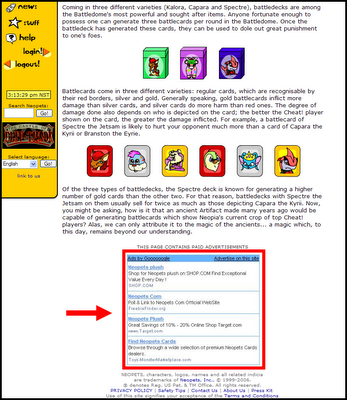
After:
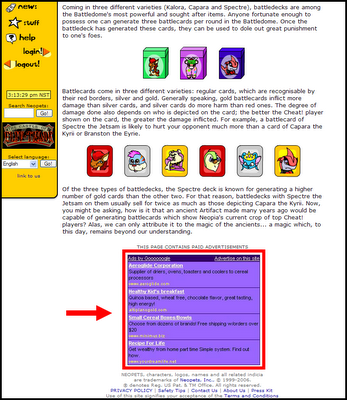
During this Optimization Month, follow Chris' example and test whether your ad colors are the best ones for your site by using channels and A/B testing. Being smart about your site and your users can yield great results.
Posted by Phoebe Ho - AdSense Optimization Team
Scene 2: You stroll down the trendiest street in a cosmopolitan city, surrounded by flashy billboards and vibrant window displays. Gleaming Italian sports cars roar past you as you head to a nearby 4-star restaurant. Next to this fine dining establishment, you gawk at the small one-story cement building next to it, on top of which looms a 50-foot-tall inflated gorilla, advertising an upcoming used car sale.
Tip: Don't let your ads be the orange tuxedo or the giant inflated gorilla. Their design should be determined with respect to their surroundings (your site) and their viewers -- your site's users.
Blending your ads in with the color scheme of your site decreases ad blindness and in most cases can increase revenue. However, you should always keep in mind how your users will respond, and test what colors your users will respond to. (Sometimes it's okay to stand out a little.)
Take Neopets, for example -- a website for kids to adopt, nurture, and play games with their virtual pets. Chris Davis, the VP of sales for Neopets, used channels and A/B testing to discover that bolder colors which made his ads stand out worked better than blended colors. After making changes to his ads, Chris was able to double both his clickthrough rate and his revenue.
Before:
After:
During this Optimization Month, follow Chris' example and test whether your ad colors are the best ones for your site by using channels and A/B testing. Being smart about your site and your users can yield great results.
Posted by Phoebe Ho - AdSense Optimization Team
Set your site on fire!
On the AdSense team we're always talking about "hot" (good) and "cold" (bad) ad placement. I love this approach and I find myself analyzing my everyday life in the same way.
Just the other day, I had some friends over for dinner and placed the appetizer in a very "cold" place, in particular, a coffee table that my puppy Tori could reach. Needless to say, she wasted no time teaching me a lesson by eating the salmon in one gigantic bite. She was satisfied, and I was down about $20.
The lesson for AdSense is that "cold" ad placement on your pages can cost you, so if you're looking to maximize your earnings, try to place your ads in "hot" places on your site. (This can be hard to figure out because often you're juggling your users' experience and the existing layout of your site.)
The most general tip I can give is that an ad placed above the fold is "hot," and one placed below the fold is "cold." I'm not sure if that rhyme at the end will help you remember this, but I sure hope that it does. Beyond that, you need to start thinking about your site design in order to create the "hottest" ad placement. The first thing you should consider is whether your site is vertically or horizontally organized. If your site is vertically based, you might consider trying to integrate a "blazing" skyscraper on the left hand side of your pages. On the other hand, for more horizontally laid out sites I love seeing a "smoking" leaderboard placed right below the title or the first section of content. Both of these placements fit within our traditional heatmap and should work well on your sites.
The next thing you should consider is placing your ad in the "hottest" spot of them all -- the middle of the page above the fold. Let me qualify this by saying that placing a one of our button or half-banner ad formats in this location just for the sake of having an ad in this middle of the page is not a good idea. In keeping with the vertical vs. horizontal theme, you should look to see if leaderboard, banner or rectangle will fit for you and your users in this location. Other considerations are whether or not the ad itself can be wrapped by your content or if it will function as a divider between two sections of content or navigation.
I hope that the story about Tori the puppy and these examples help you create the hottest site possible. One last note: you'll never know what type of results you can get without experimenting. So start seeing what hot spots your site holds for you.
P.S. No animals were harmed in the writing of this post!
Posted by Geoff Vitt - AdSense Optimization Team
Just the other day, I had some friends over for dinner and placed the appetizer in a very "cold" place, in particular, a coffee table that my puppy Tori could reach. Needless to say, she wasted no time teaching me a lesson by eating the salmon in one gigantic bite. She was satisfied, and I was down about $20.
The lesson for AdSense is that "cold" ad placement on your pages can cost you, so if you're looking to maximize your earnings, try to place your ads in "hot" places on your site. (This can be hard to figure out because often you're juggling your users' experience and the existing layout of your site.)
The most general tip I can give is that an ad placed above the fold is "hot," and one placed below the fold is "cold." I'm not sure if that rhyme at the end will help you remember this, but I sure hope that it does. Beyond that, you need to start thinking about your site design in order to create the "hottest" ad placement. The first thing you should consider is whether your site is vertically or horizontally organized. If your site is vertically based, you might consider trying to integrate a "blazing" skyscraper on the left hand side of your pages. On the other hand, for more horizontally laid out sites I love seeing a "smoking" leaderboard placed right below the title or the first section of content. Both of these placements fit within our traditional heatmap and should work well on your sites.
The next thing you should consider is placing your ad in the "hottest" spot of them all -- the middle of the page above the fold. Let me qualify this by saying that placing a one of our button or half-banner ad formats in this location just for the sake of having an ad in this middle of the page is not a good idea. In keeping with the vertical vs. horizontal theme, you should look to see if leaderboard, banner or rectangle will fit for you and your users in this location. Other considerations are whether or not the ad itself can be wrapped by your content or if it will function as a divider between two sections of content or navigation.
I hope that the story about Tori the puppy and these examples help you create the hottest site possible. One last note: you'll never know what type of results you can get without experimenting. So start seeing what hot spots your site holds for you.
P.S. No animals were harmed in the writing of this post!
Posted by Geoff Vitt - AdSense Optimization Team
Tuesday, 8 August 2006
For every optimization action, there is a user reaction
You build a site to attract visitors, but the more visitors you get, the more expensive it becomes to maintain the site. So, like many other publishers, you turn to online advertisements for revenue. But if your visitors don't find the ads useful (or worse, find them obtrusive), you could potentially end up losing both users and your revenue stream.
So for this week’s post on placement optimization, we’ll focus on the behavior, and the reaction, of users.
User Behavior
AdSense’s content-matching technology is designed to provide useful links and resources for your site’s visitors -- but they won’t find the links useful if they can’t find them at all!
User Reaction
As emphasized previously, you know your visitors best, so we encourage you to be sensitive to their needs and interests.
Posted by Sandra Tsui - AdSense Optimization Team
So for this week’s post on placement optimization, we’ll focus on the behavior, and the reaction, of users.
User Behavior
AdSense’s content-matching technology is designed to provide useful links and resources for your site’s visitors -- but they won’t find the links useful if they can’t find them at all!
- Take a look at each page on your site and imagine yourself as one of your site's visitors. Would he or she rarely scroll down? If so, be sure to place an ad unit above the fold. If there is plenty of engaging content below the fold, feel free to monetize the space with more ad units.
- The typical newbie mistake is to place a leaderboard at the very top of the page. In our tests, however, we’ve found that users’ line of vision typically goes straight to the area below the header. You might find that moving the top leaderboard or banner below your site’s header would most likely result in an increase in CTR.
- On that same note, there is a significant difference in having an ad unit directly after your content versus after the footer, the “contact us” link, or a chunk of white space (remember: white spaces don’t make you money!). One publisher who had a border around his articles saw a 300% increase in CTR when he simply moved his ad unit within the border. Similarly with forums, moving a leaderboard from under the footer to directly after the last post typically results in a 200% increase.
- And the best tip we have in this category is (you’ve guessed it): an embedded rectangle unit. An ad within an article can serve as a “commercial break” for users who are tired of reading. Not only are CTRs usually in the range of .5%-2%, but they’re also a popular unit for site-targeting campaigns.
User Reaction
As emphasized previously, you know your visitors best, so we encourage you to be sensitive to their needs and interests.
- If the content is generated by your users, e.g. via forums and profile pages, they most likely won't want their content to be interrupted by an ad. Some publishers have established a premium membership plan that removes all ads for paying members, but monetizes all non-premium member pages with ads.
- For any dramatic changes in ad placement, you can certainly try making the change to a small percentage of the site to see how your users respond. If your CTR is substantially higher with the new placement, that may be an indication that people are finding the ads useful rather than obtrusive.
- Review your page content to see if visitors would prefer to have related links after reading the content. One publisher said, “Text-based ads work especially well in placements where the user expects and wants links that are related to the main content. However, we don’t trick the user and instead experiment rather conservatively – and we concentrate on the things that matter in the end: quality of content, usability and service. If you find the right balance, you will be able to successfully monetize your website with ads while providing a positive user experience to your visitors.”
Posted by Sandra Tsui - AdSense Optimization Team
Subscribe to:
Posts (Atom)